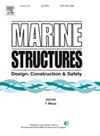An analytical model for dynamic responses of one operating offshore wind turbine structure supported by bucket foundation
IF 5.1
2区 工程技术
Q1 ENGINEERING, CIVIL
引用次数: 0
Abstract
Recently, the bucket foundation has gained prominence in offshore wind farm (OWF) due to their superior bearing capacity and lower costs. However, higher towers and larger blades may pose significant vibration safety issues to offshore wind turbine (OWT) structures when OWFs continue developing towards deep-sea areas. It is increasingly crucial to accurately simulate the dynamic response of OWT supported by bucket foundation with the current challenges, including the need to corroborate finite element simulations with actual measurement data and the consideration of bucket-soil interaction and dynamic stiffness. In this research, a analytical model of dynamic responses for one operating OWT supported by bucket foundation was firstly established based on the multi-degree-of-freedom vibration theory. In response to the limitations of existing models, a novel bucket-soil interaction model was introduced considering the dynamic changes in foundation stiffness under external excitation and the influence of soil inside the bucket. The global model simulated wind loads, operational loads, and aerodynamic damping, and the Crayfish Optimization Algorithm (COA) was applied to correction formula of aerodynamic damping based on the measurement data. Furthermore, its accuracy was validated in both shutdown and operating modes by comparing the displacement and acceleration responses at the tower top. Finally, the structural responses were studied under extreme conditions such as earthquakes, wind, waves, and typhoons. It is concluded that the observed response growth trends of the tower-top displacement and acceleration of the established model are consistent with the actual trends observed in the prototype under the operating and shutdown conditions. In operating mode, the average deviations of the displacement and acceleration between the analytical model and the actual OWT structure are 7.18 % and 4.14 %, respectively. The model is suitable for OWT response analysis under seismic intensities below 0.3 g and typhoon of return period of 20 year. It is indicated that the proposed analysis model has good engineering application value for the vibration response simulation of actual OWT.
基于桶形基础的海上风电机组结构动力响应分析模型
近年来,桶形基础以其优越的承载能力和较低的成本在海上风电场(OWF)中得到了突出的应用。然而,随着海上风力机向深海地区发展,更高的塔和更大的叶片可能会给海上风力机结构带来重大的振动安全问题。在当前的挑战下,准确模拟桶形基础支撑的水泥土动力响应变得越来越重要,包括需要用实际测量数据来验证有限元模拟,以及考虑桶土相互作用和动力刚度。本文首先基于多自由度振动理论,建立了某桶形基础支撑下运行水轮机的动力响应分析模型。针对现有模型的局限性,考虑外激励下基础刚度的动态变化和桶内土体的影响,提出了一种新的桶-土相互作用模型。该模型模拟了风荷载、操作荷载和气动阻尼,并基于实测数据采用小龙虾优化算法(COA)对气动阻尼公式进行了修正。此外,通过比较塔顶的位移和加速度响应,验证了其在关闭和运行模式下的准确性。最后,对结构在地震、风、浪、台风等极端条件下的响应进行了研究。结果表明,在运行和停机条件下,所建立的模型的塔顶位移和加速度响应增长趋势与原型机实际观测趋势一致。在运行模式下,分析模型的位移和加速度与实际OWT结构的平均偏差分别为7.18%和4.14%。该模型适用于0.3 g以下地震烈度和20年复发期台风条件下的OWT响应分析。结果表明,所建立的分析模型对实际水轮机的振动响应仿真具有较好的工程应用价值。
本文章由计算机程序翻译,如有差异,请以英文原文为准。
求助全文
约1分钟内获得全文
求助全文
来源期刊

Marine Structures
工程技术-工程:海洋
CiteScore
8.70
自引率
7.70%
发文量
157
审稿时长
6.4 months
期刊介绍:
This journal aims to provide a medium for presentation and discussion of the latest developments in research, design, fabrication and in-service experience relating to marine structures, i.e., all structures of steel, concrete, light alloy or composite construction having an interface with the sea, including ships, fixed and mobile offshore platforms, submarine and submersibles, pipelines, subsea systems for shallow and deep ocean operations and coastal structures such as piers.
 求助内容:
求助内容: 应助结果提醒方式:
应助结果提醒方式:


